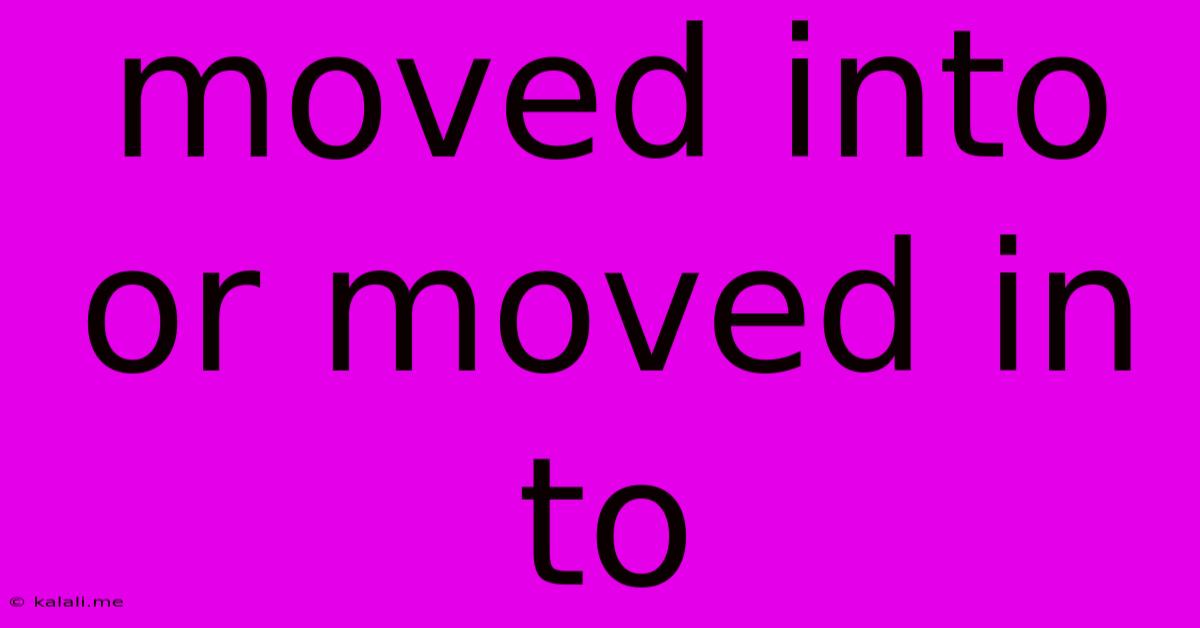Moved Into Or Moved In To
Kalali
Jun 01, 2025 · 3 min read

Table of Contents
Moved Into vs. Moved In To: Understanding the Difference
Choosing between "moved into" and "moved in to" can be tricky, even for native English speakers. This seemingly minor grammatical detail can significantly impact the clarity and professionalism of your writing. This article will clarify the difference between these two phrases, providing you with the knowledge to use them correctly in any context. We’ll explore their grammatical structures and offer examples to solidify your understanding.
The Key Difference: Phrasal Verb vs. Prepositional Phrase
The core difference lies in the grammatical function of "in." "Moved into" is a phrasal verb, meaning "moved" and "into" function as a single unit, expressing a complete action. Conversely, "moved in to" involves a prepositional phrase, where "in" acts as a preposition modifying a following noun or phrase.
Understanding "Moved Into"
"Moved into" is used to describe the act of entering and occupying a new place. It’s a concise and commonly used way to express this action. Think of it as a single, indivisible action.
-
Examples:
- "We moved into our new house last week."
- "The family moved into the apartment building."
- "She moved into a smaller apartment after her divorce."
Understanding "Moved In To"
"Moved in to" uses "in" as a preposition followed by another phrase, often a verb or a longer prepositional phrase. The meaning is significantly different, and it requires additional context for clarity.
-
Examples:
- "He moved in to help his elderly parents." (Here, "to help" is the object of the preposition "in" - he moved in for the purpose of helping.)
- "They moved in to avoid the rising rent in the city center." (Similar to the above, "to avoid" explains the reason for moving in.)
- "She moved in to a new role with greater responsibilities." (This refers to moving into a new position or job, not a physical location.)
When to Use Which Phrase
The best way to choose between these phrases is to consider whether you are describing a physical relocation or using "in" as a preposition to introduce a purpose or further description.
-
Use "moved into" when describing the act of physically entering and occupying a new space (house, apartment, building, etc.).
-
Use "moved in to" only when "in" introduces a further explanation or purpose for the movement. Ensure your sentence structure clearly shows the distinct purpose.
Common Mistakes and How to Avoid Them
A common mistake is using "moved in to" when "moved into" is appropriate. Always check if "in" is acting as part of the verb or introducing a separate phrase.
In Summary:
Understanding the difference between "moved into" and "moved in to" is crucial for clear and grammatically correct writing. By remembering that "moved into" is a phrasal verb indicating physical relocation and "moved in to" uses "in" as a preposition introducing a further description, you can confidently select the appropriate phrase to convey your meaning accurately. Choosing the correct phrase will elevate the quality and clarity of your writing, ensuring your message is easily understood.
Latest Posts
Latest Posts
-
How To Find Voltage Across A Resistor
Jun 03, 2025
-
Best Way To Organize Iphone Apps
Jun 03, 2025
-
How To Check If Alternator Is Working
Jun 03, 2025
-
Why Is The Inside Of My Dryer Wet
Jun 03, 2025
-
Which Way Does Air Flow In Furnace
Jun 03, 2025
Related Post
Thank you for visiting our website which covers about Moved Into Or Moved In To . We hope the information provided has been useful to you. Feel free to contact us if you have any questions or need further assistance. See you next time and don't miss to bookmark.